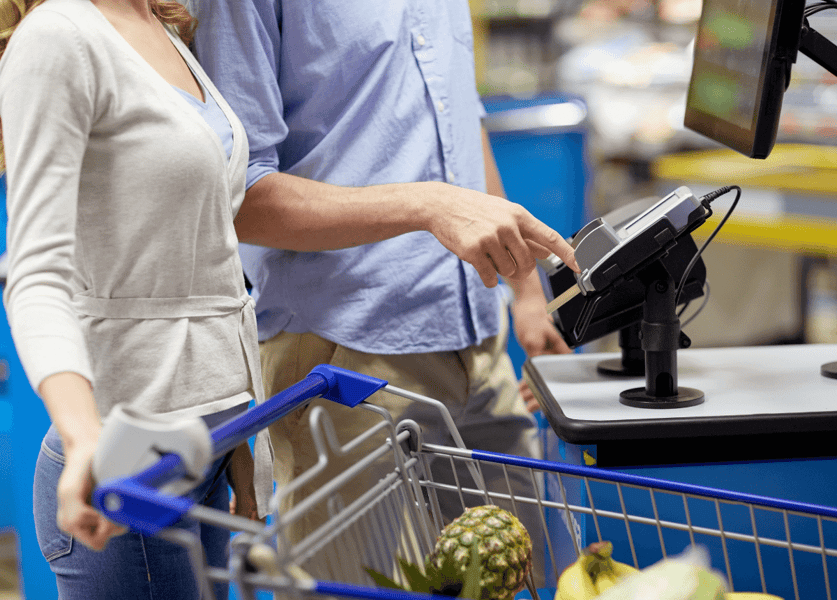How to Identify and Reduce Self-Checkout Theft and Fraud
Retail Pedro Ramos
Pedro Ramos

Nearly every major retail grocery brand now has self-checkout as a self-service alternative to traditional cashier-staffed checkout for their shoppers. About 90% of Americans have used self-checkout and their popularity is only growing as consumers seek contactless options in the wake of a global pandemic. Self-checkouts have significant benefits for retailers too, as they save labor, increase productivity, and shorten waiting times. However, beneath the benefits of automation lies some significant risks. The lack of oversight by store personnel creates a significant risk of mistakes, theft, and fraud at the self-checkout kiosk.
How Common is Self-Checkout Fraud?
A recent survey found nearly one in five shoppers polled said they had stolen something from a self-checkout lane. Industry experts estimate that thefts at self-checkout tills have doubled within the last four years. Another study examined 1 million self-checkout transactions in the United Kingdom and found losses incurred through self-service kiosks came to nearly 4% of the stock, compared to just 1.47% otherwise.
Research shows that part of the reason for higher theft rates is the people who ordinarily would not steal see this as “gaming the system” rather than outright theft. Industry experts explain that self-checkout thieves often rationalize their bad behavior — perhaps by blaming their theft on machine glitches, thinking they’re owed compensation for their “work” at the kiosk, or even telling themselves it was an honest mistake. Whether due to these or some other rationalization, it seems clear that some people are more likely to steal from machines more readily than human cashiers.
Types of Self-Checkout Theft
It’s clear that there’s a lot of theft and fraud going on in the self-checkout lane. Luckily, there are certain trends, scams, and schemes that operators can learn to look out for. Below are several common types of theft and fraud commonly found at the self-checkout kiosk.
The Banana Trick
While attempting to reduce instances of shoplifting, one retailer discovered that they had sold more carrots than they had ever had in stock. Looking deeper at their transaction data, they also found that some customers were purchasing up to 40lbs of carrots in a single transaction. This wasn’t a sudden switch to healthy eating, but rather an indication of a new type of self-checkout fraud.
The Banana Trick was originally discovered by grocers as a clever strategy used by shoplifters where a low-priced item, such as a banana, is manually keyed in or scanned while placing another, high-priced, object onto the scale or into their bags. This scheme takes advantage of the ignorance of the machine. It involves customers choosing a code on the machine for a much cheaper item, such as bananas, carrots, or pinto beans, when they’re actually scanning pricier items that require a PLU.
“The Pass Around” aka Skip Scanning
Items that leave the cart and are placed in the bag without being scanned at all are stolen with the “pass around” method. In other words, the customer scans one item and places it, plus a second unscanned item in the bagging area, or simply walking out with the item still in their cart. Provided the retailers have weight discrepancy controls in place this will be detected by the self-checkout. The data for interventions can be captured in a good data analytics application.
“The Switcheroo” aka Barcode Switching
This method involves a little more work before getting to the self-checkout kiosk. Here the customer removes the price sticker of a lower priced item and sticks it over the barcode of a higher-priced item. Successful “switcheroos” are only done with things that have close to the same weight, to avoid triggering the “unexpected item in bagging area” alert, locking up the checkout screen, and requiring management override.
Buying Gift Cards with Stolen Credit Cards
Stolen credit cards are an increasing concern in retail, and self-checkout is no different. When a thief successfully steals a credit card, their first stop is often the nearest store that sells gift cards, including most grocery stores. Once there, the thief spends the funds on gift cards before the credit card’s owner can cancel it.
Identifying Instances of Self-Checkout Theft and Fraud
There is inherently an increased risk of theft associated with self-checkout compared to staffed lanes. In addition to knowing the common ways that self-checkout theft and fraud can occur, it’s important to highlight how operators can identify when these scams and schemes are being used against them.
Attentive Attendants
The first line of defense protecting your organization from self-checkout theft and fraud is an attentive, engaging and properly trained employee on duty. This alone can stop up to 90 percent of customer theft whether deliberate or accidental. In addition to being attentive and looking for potential theft, this employee should be engaging and willing to help frustrated customers struggling with the checkout process. Whether the employee is a store associate, a security guard, or an Asset Protection/Loss Prevention representative (or some combination of all of the above), when customers come across someone who’s curious and outgoing they’re less likely to steal and remain honest.
Security Scale and CCTV Cameras
A security scale in the bagging area of the self-checkout kiosk is another great deterrent against theft both intentional and accidental by alerting both the customer and the attendant when an item is added to the bagging area without being scanned. Used in conjunction with a good data analytics application that’s integrated to CCTV, scales can be a great deterrent and training tool for attendants. Identifying patterns in data that point to potential issues with specific customers and or attendants along with the video as evidence) can go a long way towards creating a self-checkout environment that minimizes shrink exposure.
A Modern, Integrated Analytics Tool
A data analytics system, like Agilence’s platform, is an invaluable tool in the battle against fraud in the self-checkout lane. Often, when a customer is caught intentionally stealing from the self-checkout, it isn’t their first time. As mentioned above, tracking data patterns and validating them with video can be used to identify specific customers and other instances of theft. Data analytics with both transaction data and inventory data will also be able to help identify the item(s) stolen. Identifying specific attendants which excessive abandoned orders or using the same reason codes for scale overrides can help with developing training and awareness programs for attendants.
Data analytics can also be used to automatically flag suspicious transactions, like those containing multiple pre-paid gift cards that may be indicative of a stolen credit card. Other suspicious transactions might include above-average weights for produce, like the 40lbs of carrots example cited above. The ability to send automated alerts to store managers, or even directly to self-checkout attendants can allow them to investigate these suspicious transactions in near real-time.
Despite the Risks, Self-Checkout Offers Clear Benefits for Grocers
Self-checkout inherently comes with a certain amount of risk, but also offers a number of significant benefits to grocers. Labor savings alone can often offset any external shrink associated with the adoption of these technologies. Self-checkout lanes also improve customer satisfaction by reducing wait times when shoppers are in a hurry, helping deal with sudden traffic increases, and offering a contactless payment process.
By following the best practices outlined above, grocers can minimize the risk of preventable self-checkout shrink while enjoying the benefits of these convenient self-service options.
Recently, Agilence teamed up with Loss Prevention Magazine on a research report aimed at measuring the changing perceptions and value of Loss Prevention teams. Responses were collected from a hundred LP professionals at every level, operating in various industries. Download your free copy of the full report today to see the results.
Related Articles

Exploring the Psychology of Self-Checkout Theft
The mass adoption of self-checkout systems by grocers has been a significant shift towards efficiency and convenience for sto...
Gas Stations Using Data Analytics To Predict & Track Sales
Running a successful gas station as a sole operation or as an extension to a grocery or convenience chain means juggling nume...%20(2)%20(1).png)
How to Safeguard Your Cashierless Grocery Store
Grocers are welcoming customers back to the store. But where they spend their time is a make-it-or-break-it proposition. Dwel...Subscribe to our blog
Receive free educational resources like exclusive reports, webinars, and industry thought leadership articles straight to your inbox.


